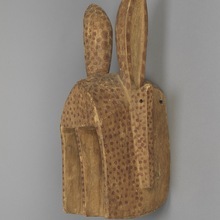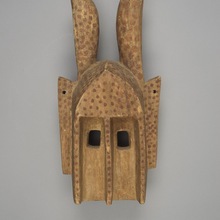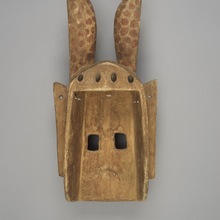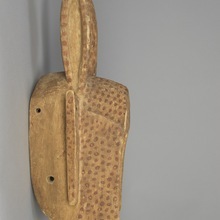Hare Mask
MOA: University of British Columbia
3362/3
Hare mask of carved and painted wood. Front of mask has a flat arched forehead with two long, deep rectangular carved out sections below (leaving three long dividing lines level with the forehead). Within are two small cutout rectangular eye holes. Extending up from the head are two large rabbit ears, facing outwards. Down each side of the head are long human-like ears with a single hole drilled through the top. There are two holes drilled horizontally through the mask behind each ear, and four holes drilled through at an angle along the top edge of the back. There are many small holes randomly drilled all over. The ears and face are painted with small reddish-brown dots.
-
Iconographic Meaning
Hare masks are painted black and white, to signify cleansing, and red and yellow, to represent good fortune. The red dots on this mask are meant to mimic the texture of fur. If a mask is faded, like this one is, then the cultural value lessens and it can be sold to create income for Dogons.
-
History Of Use
The hare mask (jomo or dyommo), alongside two birds, represent game pursued by Dogon hunters (dannana). The hare is one of three mythic animals which are said to have died because they ate part of the fonio harvest. During masked performances, the hare mask dancer mimics the shy hiding behavior of hares, and will hop. They are then scared from performances by the hunter who chases them to hide in the audience. A rite these are worn at is the dama, a funerary ritual. It usually marked with music, synchronized dancing, and wooden painted masks with the purpose to guide the deceased elders’s spirit into the spiritual afterlife. Only men can participate, while women and children observe from a distance. The dama is used to ensure all spirits are moved onto afterlife, so that no spirits are left in the villages as they believe wandering spirits can bear misfortune. These masks, and all sculpture and masks, are made by blacksmiths (dogo bana, meaning master of the Dogon). The two groups of smiths are the Jemo, who live on the plateau, and the Iru, who are the former slaves of the Jemo. In Dogon mythology, the first blacksmiths were said to have descended from heaven to bring mankind fire, iron, and seeds for cultivation. They hold a highly privileged place in Dogon society.
- Type of Item mask
- Culture Dogon
- Material wood, paint
- Measurements height 44.5 cm, width 22.0 cm, depth 17.5 cm (overall)
- Previous Owner Alexander Lamb Antiques
- Received from Alexander Lamb Antiques, Museum of Anthropology Acquisitions Budget
- Made in Mopti
- Ownership Date before May 11, 2019
- Acquisition Date on May 11, 2019
- Condition good
- Accession Number 3362/0003



